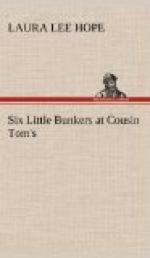“Does he mean we must all get a piece of board?” asked Violet.
“No,” answered her mother with a smile. “Russ is saying what the sailors say when they want every one to get on the ship, take their places, and be ready for the start.”
The rowboat was a large one, and would hold the six little Bunkers, as well as their daddy and mother and Cousin Tom.
Cousin Ruth had intended to go, but, at the last minute, the woman living in the next bungalow asked her to help with some sewing; so Cousin Ruth stayed at home.
“I’ll get all ready to cook the crabs if you catch any,” she said with a smile, as Cousin Tom and Daddy Bunker rowed the boat out into the inlet.
“Oh, we’ll get some!” cried Russ.
“Crabs bite, don’t they?” asked Violet, who seemed started on her questioning tricks.
“Well, they don’t exactly bite; it’s more of a pinch,” said Cousin Tom. “But it hurts, I can tell you.”
“Then I’m not going to catch any,” declared Violet. “I’ll just watch you.”
“Oh, a crab won’t pinch you if you catch him in a net; and that’s what I’ll do,” said her cousin. “We’ll soon be at the place where there are lots of them, I hope.”
As Cousin Tom rowed along, he told the six little Bunkers that the crabs swam up the inlet from the sea to get things to eat, and also for the mother crab to lay eggs, so little crabs would hatch out.
“And when the big crabs swim up, which they do whenever the tide runs into the inlet, twice a day,” said Cousin Tom, “we go out and catch them. Of course you can catch them at other times, but the crabbing is best when the tide is coming in.”
“But I don’t see any hooks on the lines,” remarked Laddie, who was looking at the strings in the bottom of the boat. On one end of each string was a short piece of wood, and on the other end a piece of meat, while on a few were some fish heads.
“You don’t need hooks to catch crabs,” explained Cousin Tom. “All you need to do is to tie a piece of meat on the string.”
“And does the crab bite that?” asked Russ.
“No, but he takes it in his strong claws, to hold it so he can tear off little pieces with his smaller claws and put them into his mouth,” said Cousin Tom. “A crab’s mouth is small, and he has to tear his food into little bits before he can swallow it. He uses his big front claws for grabbing hold of what he wants to eat and holding on to it, and he likes old meat or fish heads best of all.
“So, when we get to the place where I think some crabs are, we’ll let down the pieces of meat. The crabs, swimming along, or crawling sideways on the bottom of the inlet, as they more often do, will smell the chunk of meat. They will take hold of it in their claws, and then one of us can reach down the net and scoop it under Mr. Crab. That’s how we catch them.”
“But how do you know when one has hold of the piece of meat on the string?” asked Rose.




